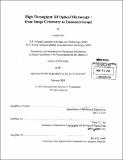| dc.contributor.advisor | Peter T.C. So. | en_US |
| dc.contributor.author | Choi, Heejin | en_US |
| dc.contributor.other | Massachusetts Institute of Technology. Department of Mechanical Engineering. | en_US |
| dc.date.accessioned | 2014-06-13T22:38:24Z | |
| dc.date.available | 2014-06-13T22:38:24Z | |
| dc.date.copyright | 2014 | en_US |
| dc.date.issued | 2014 | en_US |
| dc.identifier.uri | http://hdl.handle.net/1721.1/87973 | |
| dc.description | Thesis: Ph. D., Massachusetts Institute of Technology, Department of Mechanical Engineering, 2014. | en_US |
| dc.description | Cataloged from PDF version of thesis. | en_US |
| dc.description | Includes bibliographical references. | en_US |
| dc.description.abstract | Optical microscopy is an imaging technique that allows morphological mapping of intracellular structures with submicron resolution. More importantly, optical microscopy is a technique that can readily provide images with biochemical contrast based on different spectroscopic modalities such as fluorescence spectrum and lifetime, Raman spectrum, optical polarization and phase. Although, optical microscopy can provide superior resolution over many other medical imaging modalities such as MRI, CT or ultrasound, the relatively low throughput limits its range of biomedical application. In this thesis, high throughput 3D optical imaging instruments have been developed for medical and biological applications based on widefield 3D resolved techniques. First, we developed a high throughput depth resolved widefield image cytometer based on the structured light illumination and the high speed remote depth scanning. This system improves imaging throughput by an order of magnitude over the current technology and can potentially be applied to image cytometry investigation to study cultured cell morphologies with statistical significance comparable to the flow cytometer. The statistical accuracy of this instrument is verified by quantitatively measuring the rare cell populations. Hyperspectral imaging is also possible based on the use of an interferometric full field spectrometer. Second, we developed a depth resolved widefield two photon endomicroscope for the medical diagnosis based on the temporally focused widefield two photon microscopy. The developed instrument can parallelize the image acquisition process over the whole field of view without the need for any scanning mechanism at the distal end of the optical fiber. The method for delivering high peak power laser pulses through the optical fiber has been proposed to improve the signal to noise ratio which in turn improves the imaging throughput. A structured light illumination method have also been proposed and demonstrated for improving depth resolution. In addition, this temporally focused widefield two photon microscopy has been applied to the high throughput depth resolved measurement of fluorescence and phosphorescence lifetime with millisecond level frame rate. | en_US |
| dc.description.statementofresponsibility | by Heejin Choi. | en_US |
| dc.format.extent | 142 pages | en_US |
| dc.language.iso | eng | en_US |
| dc.publisher | Massachusetts Institute of Technology | en_US |
| dc.rights | M.I.T. theses are protected by copyright. They may be viewed from this source for any purpose, but reproduction or distribution in any format is prohibited without written permission. See provided URL for inquiries about permission. | en_US |
| dc.rights.uri | http://dspace.mit.edu/handle/1721.1/7582 | en_US |
| dc.subject | Mechanical Engineering. | en_US |
| dc.title | High throughput 3D optical microscopy : from image cytometry to endomicroscopy | en_US |
| dc.type | Thesis | en_US |
| dc.description.degree | Ph. D. | en_US |
| dc.contributor.department | Massachusetts Institute of Technology. Department of Mechanical Engineering | |
| dc.identifier.oclc | 880689741 | en_US |
